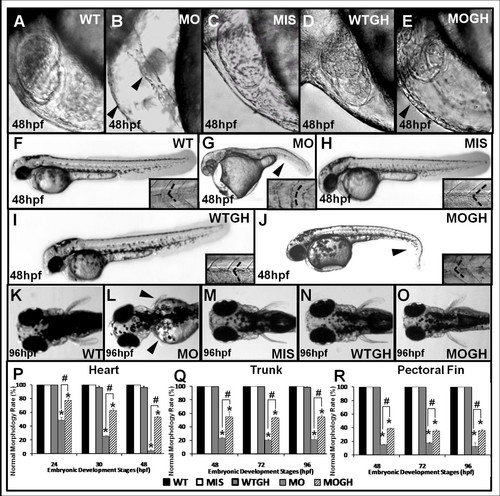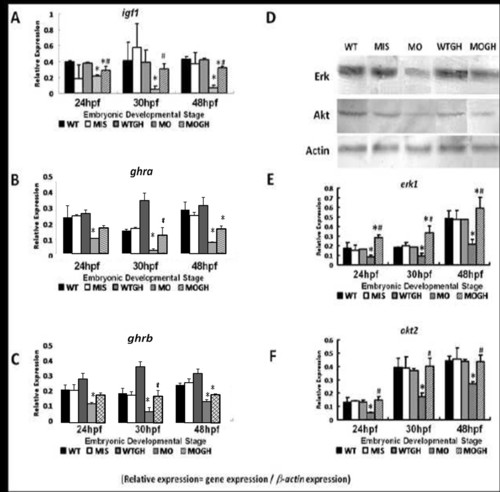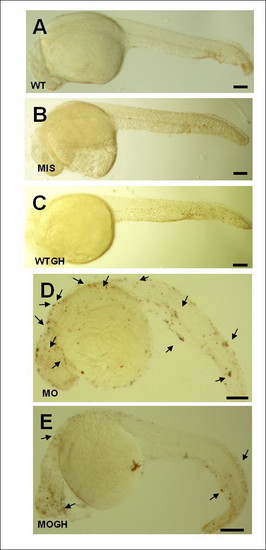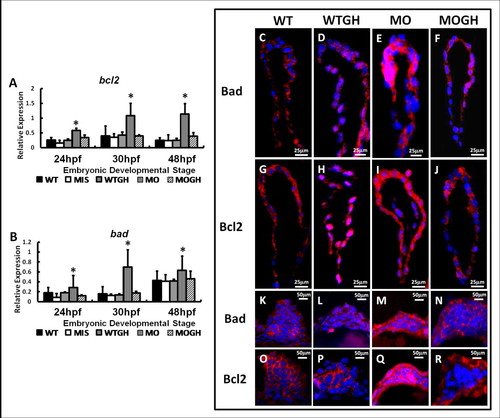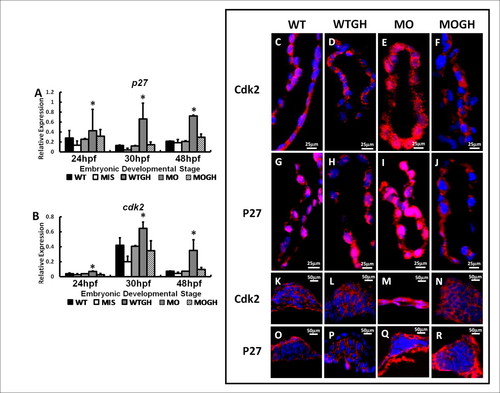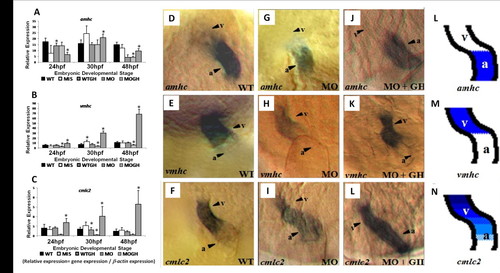- Title
-
The paracrine effect of exogenous growth hormone alleviates dysmorphogenesis caused by tbx5 deficiency in zebrafish (Danio rerio) embryos
- Authors
- Tsai, T.C., Lu, J.K., Choo, S.L., Yeh, S.Y., Tang, R.B., Lee, H.Y., and Lu, J.H.
- Source
- Full text @ J. Biomed. Sci.
|
Phenotypes oftbx5knockdown and GH-treated zebrafish embryos. The normal appearance of hearts in wild-type (WT) (A) and MIS (C) group embryos and string-like hearts occurring in MO (B) group embryos are depicted. In WTGH embryos (D), hearts are identical to those of the WT (A) group, and hearts of MOGH group embryos (E) showed improvements. No significant differences were observed in trunks of WT (F), MIS (H), and WTGH group embryos (I), in which trunks were straight and somites appeared “V-shaped.” On the other hand, trunks of embryos injected with tbx5-MO were severely bent (G) and had “U-shaped” somites, but these were partially restored in MOGH group embryos (J). In the MO group (L), truncated or undeveloped pectoral fins were demonstrated; nevertheless, WT (K) embryos micro-injected with mismatched tbx5-MO (M), WT (N) exogenous GH–treated embryos, and tbx5-deficient embryos exhibited normal appearances. Statistically, the normal morphogenetic rates of the heart (P), trunk (Q), and pectoral fins (R) were significantly lower in the MO group and partially improved in the MOGH group. Defective embryos were not found in the WT or MIS groups and almost all of the embryos in the WTGH group developed properly. Data are presented as mean ± S.D. *p < 0.05 vs. WT; #p < 0.05 MO + GH vs. MO. Black arrowhead, defect site; dashed line, shape of somite border; MO, tbx5 knockdown; MIS, mismatch tbx5-MO-treated embryos; WTGH, WT embryos treated with GH; MOGH, tbx5-MO- and GH-treated embryos. |
|
Expressions ofigf1, ghra, ghrb, akt2,and erk1 in tbx5 knockdown embryos. (A) The expression of igf1 was significantly reduced in MO group embryos throughout the developmental stages. Its expression in WTGH and MIS embryos was similar to the control and wild-type (WT) groups. The expression of igf1 was significantly restored in the WTGH treatment group. Expressions of GH receptors ghra (B) and ghrb (C) were significantly depressed in MO embryos but restored in the MOGH treatment group. (D) In the Western blot analysis, protein expressions of Akt and Erk in MO zebrafish embryos were depressed, but expressions were similar among the WT, MIS, and WTGH groups at 30 h post-fertilization (hpf). Expressions of Akt and Erk were restored in the MOGH group. In the semiquantitative PCR analysis, mRNA expressions of erk1 (E) and akt2 (F) were significantly reduced in MO group embryos and restored in the MOGH group. Data are presented as the mean ± S.D. *p < 0.05 vs. WT; #p < 0.05 MOGH vs. MO. MO, tbx5 knockdown; MIS, mismatched tbx5-MO-treated embryos; WTGH, WT embryos treated with growth hormone (GH); MOGH, tbx5-MO- and GH-treated embryos. |
|
Growth hormone (GH)-treated tbx5 -knockdown zebrafish embryos show reduced apoptosis at 30 h post-fertilization (hpf). A TUNEL assay revealed no apoptotic spots in WT (A), MIS (B), and WTGH (C) embryos. (D) However, massive apoptotic spots were visible in MO embryos. (E) In the MOGH group, apoptotic sites were reduced. (A-E) Embryo anteriors are to the left. Scale bar = 0.1 cm. Black arrow, apoptotic site; WT, wild-type embryos; MO, tbx5 knockdown; MIS, mismatched tbx5-MO-treated embryos; WTGH, WT embryos treated with GH; MOGH, tbx5-MO- and GH-treated embryos. PHENOTYPE:
|
|
Expression of apoptosis-related genes and proteins in tbx5 knockdown and growth hormone (GH)-treated zebrafish embryos at 30 h post-fertilization (hpf). Using a semiquantitative RT-PCR, the apoptotic genes, bcl2 (A) and bad (B), were significantly induced in MO group embryos and showed no significant differences among the WT, WTGH, and MOGH groups. (n = 3, 50 embryos/stage; relative expression = gene expression/β-actin expression). (C-R) Zebrafish embryos were stained by apoptosis-related antibodies, Bad and Bcl2 (red), and counterstained with DAPI (blue) for nucleus observation. In sagittal sections of the heart, Bad and Bcl2 were similarly expressed and significantly induced in tbx5-deficienct embryos (E, I), and showed no significant differences among the WT (C, G), WTGH (D, H), and MOGH (F, J) groups. Transverse sections showed that expression patterns of Bad and Bcl2 in pectoral fins were significantly induced in tbx5-deficient embryos (M, Q) and showed insignificant differences among the WT (K, O), WTGH (L, P), and MOGH (N, R) groups. (C-R) Embryo anteriors are to the left. WT, wild-type embryos; MO, tbx5 knockdown; MIS, mismatch tbx5-MO-treated embryos; WTGH, WT embryos treated with GH; MOGH, tbx5-MO- and GH-treated embryos. Data are presented as the mean ± S.D. *p < 0.05 vs. WT |
|
Expression of cell cycle-related genes and proteins in tbx5 knockdown and GH-treated zebrafish embryos at 30 h post-fertilization (hpf). Cell cycle-related genes, p27 (A) and cdk2 (B), were significantly induced in MO group embryos throughout the developmental stages but were similar among the WT, WTGH, and MOGH groups. (n = 3, 50 embryos/stage; relative expression = gene expression/β-actin expression). (C-R) Zebrafish embryos was stained with cell cycle-related (Cdk2 and P27) antibodies (red) and counterstained with DAPI (blue) for nuclear observation. In sagittal sections of the heart and transverse sections of the pectoral fins, expression patterns of Cdk2 and P27 were similar in all treatment groups in that they were significantly induced in tbx5-deficienct embryos (E, I, M, Q) and showed insignificant differences among the WT (C, G, K, O), WTGH (D, H, L, P), and MOGH (F, J, N, R) groups. (C-R) The anteriors of the embryos are to the left. WT, wild-type embryos; MO, tbx5 knockdown; MIS, mismatch tbx5-MO-treated embryos; WTGH, WT embryos treated with growth hormone (GH); MOGH, tbx5-MO- and GH-treated embryos. Data are presented as the mean ± S.D. *p < 0.05. |
|
Expressions of cardiomyogenesis-related genes in GH-treatedtbx5mutants. Expressions of (A)amhc, (B)vmhc,and (C)cmlc2in MO group zebrafish embryos were depressed throughout the developmental stages compared to WT zebrafish embryos. Expression of these thre cardiac myogenesis genes showed significant restorative effects in MOGH group embryos. On the other hand, expressions of cardiac myogenesis genes were not significantly affected in WTGH group embryos. The expression of amhc was restricted to the atrium in WT embryos (D), and its expression was depressed in MO group embryos (G). (J) MOGH group zebrafish embryos showed an ameliorating effect on restoration by the expression of amhc. The expression of vmhc was restricted to the ventricle in WT embryos (E) but showed minor expression in MO group embryos (H). (K) However, the expression of vmhc was significantly induced in the MOGH group. The expression pattern of cmlc2 was similar to that of vmhc, in that expression was low in tbx5-deficient embryos (I) but was restored in GH-treated embryos (L). Schematics indicate the location of the expressions of amhc (L), vmhc (M), and cmlc2 (N). Data are presented as the mean ± S.D. *p < 0.05 vs. WT. WT, wild-type embryos; MO, tbx5 knockdown; MIS, mismatched tbx5-MO-treated embryos; WTGH, WT embryos treated with growth hormone (GH); MOGH, tbx5-MO- and GH-treated embryos; a, atrium; v, ventricle. |

